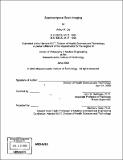Spatiotemporal brain imaging
Author(s)
Liu, Arthur K. (Arthur Kuang-Chung)
DownloadFull printable version (10.87Mb)
Other Contributors
Harvard University--MIT Division of Health Sciences and Technology.
Advisor
John W. Belliveau.
Terms of use
Metadata
Show full item recordAbstract
Understanding how the human brain works, in both health and disease, requires data with both high spatial and temporal resolution. This thesis develops and applies a spatiotemporal neuroimaging method. I describe a linear estimation inverse approach, which is a method for the combination of functional magnetic resonance imaging (fMRI) with electroencephalography (EEG) and magnetoencephalography (MEG). fMRI provides millimeter spatial resolution, while EEG and MEG provide millisecond temporal resolution. The thesis is divided into two broad sections: Monte Carlo modeling studies and experimental studies. Improvements to both the bioelectromagnetic forward and inverse solutions are demonstrated. Through modeling studies, I characterize the accuracy of the method with and without functional and anatomic constraints, the effects of various model mis-specifications, and as a function of EEG/MEG sensor configuration. I describe a noise sensitivity normalization to the traditional linear estimation operator that improves the point spread function (a measure of spatial resolution), increases the spatial homogeneity of the point spread, and allows interpretation of the localization in terms of a statistical measure (F-statistic). Using experimentally generated current dipoles implanted an epilepsy patient, I examine the accuracy of both a realistic and spherical EEG head model. This experimental data demonstrates the improved accuracy of the realistic head model, and gives us confidence in using this realistic head model for EEG source localization. The optimized and validated forward and inverse methods are then applied to a variety of empirical measurements. First, the combined multi modality imaging approach is used to simultaneous EEG/fMRI measurements of a visual stimulus, demonstrating the feasibility of measuring and localizing simultaneously acquired electric potential and hemodynamic measurements. Second, combined MEG/fMRI measurements are used to analyze the spatiotemporal characteristics of a cortical network that is responsive to visual motion coherency. Finally, in epilepsy patients, I compare the non-invasive MEG localization of interictal spikes with verification from invasive recordings and surgical results. These studies, in both normal volunteers and patients, clearly demonstrate the utility, accuracy, and power of the combined use of fMRI, EEG and MEG. The tools demonstrated here provide "real time movies" of the human brain at work during a given task or behavior. This information is required to develop computational models of how the human brain/mind works.
Description
Thesis (Ph.D.)--Harvard--Massachusetts Institute of Technology Division of Health Sciences and Technology, 2000. Includes bibliographical references.
Date issued
2000Department
Harvard University--MIT Division of Health Sciences and TechnologyPublisher
Massachusetts Institute of Technology
Keywords
Harvard University--MIT Division of Health Sciences and Technology.